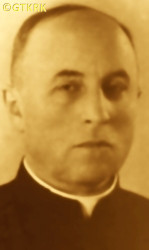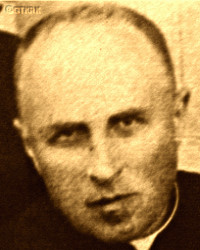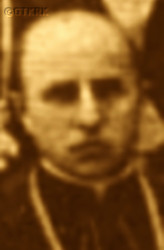Roman Catholic
St Sigismund parish
05-507 Słomczyn
85 Wiślana Str.
Konstancin deanery
Warsaw archdiocese, Poland
full list:
displayClick to display full list

searchClick to search full list by categories
wyświetlKliknij by wyświetlić pełną listę po polsku

szukajKliknij by przeszukać listę wg kategorii po polsku

Martyrology of the clergy — Poland
XX century (1914 – 1989)
personal data
surname
IWICKI
forename(s)
Witold
function
diocesan priest
creed
Latin (Roman Catholic) Church RCmore on
en.wikipedia.org
[access: 2014.09.21]
diocese / province
Pinsk diocesemore on
en.wikipedia.org
[access: 2013.05.19]
Minsk diocesemore on
en.wikipedia.org
[access: 2013.05.19]
Mogilev archdiocesemore on
en.wikipedia.org
[access: 2013.06.23]
academic distinctions
Doctor of Canon Law
Sacred Theology MA
honorary titles
prelate‐scholaster (Lat. praelati‐scholasticus)more on
prelate—scholaster (Lat. praelati—scholasticus)
(Assumption of the Blessed Virgin Mary RC cathedral church, Pinsktoday: Pinsk city dist., Brest reg., Belarus
more on
en.wikipedia.org
[access: 2022.07.16])
date and place
of death
22.01.1943

Ivanavaform.: Janów Poleski
today: Ivanava dist., Brest reg., Belarus
more on
en.wikipedia.org
[access: 2022.07.16]
details of death
Before World War I removed by Russians from his post in Mozyrz for conducting incorrect educational activities and forbidden to run such activities for 3 years.
For the first time arrested by the Russians on 20.09.1920 in Sankt Petersburg.
On.
14.10.1920 sentenced to confinement till „the end civil war in Russia”.
Held in Moscow.
Released at the beginning of 1921 and exchanged for Russian spies in Poland.
After German and Russian invasion of Poland in 09.1939 and start of the World War II, after start of the Russian occupation and in connection with the departure of both bishops from Pinsk (Bp Casimir Bukraba had to be treated in Lviv, and the suffragan Bp Charles Niemira was expelled by the Russians to the German‐run Germ. Generalgouvernement (Eng. General Governorate)) became the vicar — the bishop's deputy — of the Pinsk diocese.
After German attack in 06.1941 of their erstwhile ally, Russians, after start of German occupation organized help to the persecuted Jews.
Collaborated with Polish partisan.
Included by the Germans in a list of hostages (so‐called „Polish Committee” list), to be made responsible should partisans attack the Germans.
Arrested by the Germans on 18.01.1943 — after Polish resistance Home Army AK (part of Polish Clandestine State) attack on Pinsk prison and release of prisoners held there.
In retribution murdered — with hands at the back tied by a wire — among 30 residents of Pinsk on an old Jewish cemetery in a nearby Janów Poleski (4 Poles Germans released prior to the execution to match exactly the number of 30 hostages indicated on pre–printed announcements).
alt. details of death
According to some sources, 40 Poles were taken to the place of execution.
Then one of the Germans told the priest that there was an order to shoot 38 prisoners and offered to release him.
Fr Iwicki was said to have replied: „I will leave if you release all Poles”.
The German replied that„it is [he] who is in charge here and 38 must perish”.
Then the priest pointed to one of the hostages, prob. the manager of the railway station in Pinsk and said that „he has a wife and children.
Let him be set free and let me die”.
The victims were murdered in the clearing of Pilicki Forest, where a deep hole had previously been dug, with salvos from submachine guns.
Fr Iwicki was to be the last one to go down the pit filled with the bodies of the victims.
After the murder, the hole was buried and the tracked vehicle (tank/tractor) leveled the ground.
The Germans went to the hotel and the libation lasted until late at night…
cause of death
mass murder
perpetrators
Germans
sites and events
Help to the JewsClick to display the description, Collective responsibility („Hostages”)Click to display the description, Ribbentrop‐MolotovClick to display the description, Pius XI's encyclicalsClick to display the description
date and place
of birth
19.05.1884

Vilniustoday: Vilnius city dist., Vilnius Cou., Lithuania
more on
en.wikipedia.org
[access: 2022.01.06]
alt. dates and places
of birth
10.05.1884
presbyter (holy orders)
ordination
24.06.1907

positions held
1939 – 1943
vicar general — Pinsk RC diocese
c. 1926 – c. 1943
prelate‐scholaster (Lat. praelati‐scholasticus) — Pinsktoday: Pinsk city dist., Brest reg., Belarus
more on
en.wikipedia.org
[access: 2022.07.16] ⋄ Cathedral Chapter ⋄ Assumption of the Blessed Virgin Mary RC cathedral church — called also prelate‐theologian (Lat. praelati‐ theologus); also: member of many diocesan commissions, e.g. provisor / member of the Bishop's committee for education and discipline of the Seminary of the Clergy (c. 1939), member of the Synodal Commission (c. 1936 ‐ c. 1939), synodal examiner (c. 1929 ‐ c. 1939), member of Lat. „Consilium a Vigilantiae” (Eng. „Committee on Morals”) of the Diocesan Curia (c. 1926 ‐ c. 1939), member of the Lat. „Consilium Scholasticum” (Eng. „Educational Commission”) of the Diocesan Curia (c. 1930 ‐ c. 1932), pro‐synodal examiner (c. 1926 ‐ c. 1929), censor of religious books (c. 1926 ‐ c. 1928)
1933 – 1939
dean — Brest on Bugform.: Brest‐Litovsk /till 1923/
today: Brest, Brest dist., Brest reg., Belarus
more on
en.wikipedia.org
[access: 2021.09.29] RC deanery
1933 – 1939
parish priest — Brest on Bugform.: Brest‐Litovsk /till 1923/
today: Brest, Brest dist., Brest reg., Belarus
more on
en.wikipedia.org
[access: 2021.09.29] ⋄ Exaltation of the Holy Cross RC parish ⋄ Brest on Bugform.: Brest‐Litovsk /till 1923/
today: Brest, Brest dist., Brest reg., Belarus
more on
en.wikipedia.org
[access: 2021.09.29] RC deanery — also: county inspector of religion classes in elementary schools (c. 1939)
c. 1926 – c. 1939
judge — Pinsktoday: Pinsk city dist., Brest reg., Belarus
more on
en.wikipedia.org
[access: 2022.07.16] ⋄ Bishop's Diocesan Court — i.a. official i.e. bishop's judicial vicar (c. 1939), synodal judge (c. 1930‐1938), pro‐synodal judge (c. 1926‐1929)
c. 1926 – 1932
professor — Pinsktoday: Pinsk city dist., Brest reg., Belarus
more on
en.wikipedia.org
[access: 2022.07.16] ⋄ St Thomas Aquinas' Theological Seminary — lecturer of pastoral theology
1926 – 1930
vicar general — to Bishop Sigismund Łoziński ⋄ Pinsk RC diocese
1926 – 1928
dean — Pinsktoday: Pinsk city dist., Brest reg., Belarus
more on
en.wikipedia.org
[access: 2022.07.16] RC deanery
1926 – 1928
parish priest — Pinsktoday: Pinsk city dist., Brest reg., Belarus
more on
en.wikipedia.org
[access: 2022.07.16] ⋄ Assumption of the Blessed Virgin Mary RC cathedral parish ⋄ Pinsktoday: Pinsk city dist., Brest reg., Belarus
more on
en.wikipedia.org
[access: 2022.07.16] RC deanery
1925 – 1926
rector — Pinsktoday: Pinsk city dist., Brest reg., Belarus
more on
en.wikipedia.org
[access: 2022.07.16] ⋄ St Thomas Aquinas' Theological Seminary ⋄ Pinsk RC diocese
c. 1926 – 1932
professor — Pinsktoday: Pinsk city dist., Brest reg., Belarus
more on
en.wikipedia.org
[access: 2022.07.16] ⋄ St Thomas Aquinas' Theological Seminary — lecturer of pastoral theology
1923 – 1925
rector — Navahrudaktoday: Navahrudak dist., Grodno reg., Belarus
more on
en.wikipedia.org
[access: 2021.07.04] ⋄ Theological Seminary — Minsk diocese
1923 – 1925
professor — Navahrudaktoday: Navahrudak dist., Grodno reg., Belarus
more on
en.wikipedia.org
[access: 2021.07.04] ⋄ Theological Seminary — Minsk diocese
1921 – 1925
administrator — Niahnievičytoday: Niahnievičy ssov., Navahrudak dist., Grodno reg., Belarus
more on
be.wikipedia.org
[access: 2023.01.18] ⋄ Immaculate Conception of the Blessed Virgin Mary RC parish ⋄ Navahrudaktoday: Navahrudak dist., Grodno reg., Belarus
more on
en.wikipedia.org
[access: 2021.07.04] RC deanery
1918 – 1920
parish priest — Sankt Petersburgtoday: Saint Petersburg city, Russia
more on
en.wikipedia.org
[access: 2020.07.31] ⋄ St Stanislav the Bishop and Martyr RC parish ⋄ Sankt Petersburgtoday: Saint Petersburg city, Russia
more on
en.wikipedia.org
[access: 2020.07.31] RC deanery
from 1915
vicar — Sankt Petersburgtoday: Saint Petersburg city, Russia
more on
en.wikipedia.org
[access: 2020.07.31] ⋄ Assumption of the Blessed Virgin Mary RC pro–cathedral parish ⋄ Sankt Petersburgtoday: Saint Petersburg city, Russia
more on
en.wikipedia.org
[access: 2020.07.31] RC deanery
1914 – 1915
PhD student — Rometoday: Rome prov., Lazio reg., Italy
more on
en.wikipedia.org
[access: 2021.12.18] ⋄ canon law, „Gregorianum” [i.e. Lat. Pontificia Universitas Gregoriana (Eng. Pontifical Gregorian University)]
1909 – 1912
vicar — Mazyrtoday: Mazyr dist., Gomel reg., Belarus
more on
en.wikipedia.org
[access: 2021.12.18] ⋄ Assumption of the Blessed Virgin Mary RC parish ⋄ Mozyrz / Rzeczycadeanery names/seats
today: Gomel reg., Belarus RC deanery — prefect of local grammar school and private girls' grammar school
vicar — Slutsktoday: Slutsk dist., Minsk reg., Belarus
more on
en.wikipedia.org
[access: 2021.04.22] ⋄ St Anthony of Padua RC parish ⋄ Slutsktoday: Slutsk dist., Minsk reg., Belarus
more on
en.wikipedia.org
[access: 2021.04.22] RC deanery
till 1907
student — Sankt Petersburgtoday: Saint Petersburg city, Russia
more on
en.wikipedia.org
[access: 2020.07.31] ⋄ philosophy and theology, Imperial Roman Catholic Spiritual Academy (1842‐1918) — postgraduate specialised studies crowned with a Sacred Theology Master's degree
from 1902
student — Sankt Petersburgtoday: Saint Petersburg city, Russia
more on
en.wikipedia.org
[access: 2020.07.31] ⋄ philosophy and theology, Metropolitan Theological Seminary
others related
in death
BUKRABAClick to display biography Casimir
sites and events
descriptions
Help to the Jews: During World War II on the Polish occupied territories Germans forbid to give any support to the Jews under penalty of death. Hundreds of Polish priests and religious helped the Jews despite this official sanction. Many of them were caught and murdered.
Collective responsibility („Hostages”): A criminal practice implemented by the Germans in the occupied territories of Poland, applied from the very first day of World War II. At its core was an appointment and public announcement of a list of names of selected people whose lives depended on absolute compliance with German orders. Any violation of these ordinances, by any person, regardless of the circumstances, resulted in the murder of the designated „hostages”. In the first days of the war and occupation, it was used i.a. by the German Wehrmacht army to prevent acts of continuation of the defense by the Poles. Later, especially in the German‐run General Governorate, it was part of the official policy of the occupation authorities — collective responsibility for any acts of resistance to the occupier's practices. For the life of one German, even if death was due to customary reasons, the Germans carried out executions from a dozen to even a hundred Poles previously designated as „hostages”.
Ribbentrop‐Molotov: Genocidal Russian‐German alliance pact between Russian leader Joseph Stalin and German leader Adolf Hitler signed on 23.08.1939 in Moscow by respective foreign ministers, Mr. Vyacheslav Molotov for Russia and Joachim von Ribbentrop for Germany. The pact sanctioned and was the direct cause of joint Russian and German invasion of Poland and the outbreak of the World War II in 09.1939. In a political sense, the pact was an attempt to restore the status quo ante before 1914, with one exception, namely the „commercial” exchange of the so‐called „Kingdom of Poland”, which in 1914 was part of the Russian Empire, fore Eastern Galicia (today's western Ukraine), in 1914 belonging to the Austro‐Hungarian Empire. Galicia, including Lviv, was to be taken over by the Russians, the „Kingdom of Poland” — under the name of the General Governorate — Germany. The resultant „war was one of the greatest calamities and dramas of humanity in history, for two atheistic and anti‐Christian ideologies — national and international socialism — rejected God and His fifth Decalogue commandment: Thou shall not kill!” (Abp Stanislav Gądecki, 01.09.2019). The decisions taken — backed up by the betrayal of the formal allies of Poland, France and Germany, which on 12.09.1939, at a joint conference in Abbeville, decided not to provide aid to attacked Poland and not to take military action against Germany (a clear breach of treaty obligations with Poland) — were on 28.09.1939 slightly altered and made more precise when a treaty on „German‐Russian boundaries and friendship” was agreed by the same murderous signatories. One of its findings was establishment of spheres of influence in Central and Eastern Europe and in consequence IV partition of Poland. In one of its secret annexes agreed, that: „the Signatories will not tolerate on its respective territories any Polish propaganda that affects the territory of the other Side. On their respective territories they will suppress all such propaganda and inform each other of the measures taken to accomplish it”. The agreements resulted in a series of meeting between two genocidal organization representing both sides — German Gestapo and Russian NKVD when coordination of efforts to exterminate Polish intelligentsia and Polish leading classes (in Germany called «Intelligenzaktion», in Russia took the form of Katyń massacres) where discussed. Resulted in deaths of hundreds of thousands of Polish intelligentsia, including thousands of priests presented here, and tens of millions of ordinary people,. The results of this Russian‐German pact lasted till 1989 and are still in evidence even today. (more on: en.wikipedia.orgClick to attempt to display webpage
[access: 2015.09.30])
Pius XI's encyclicals: Facing the creation of two totalitarian systems in Europe, which seemed to compete with each other, though there were more similarities than contradictions between them, Pope Pius XI issued in 03.1937 (within 5 days) two encyclicals. In the „Mit brennender Sorge” (Eng. „With Burning Concern”) published on 14.03.1938, condemned the national socialism prevailing in Germany. The Pope wrote: „Whoever, following the old Germanic‐pre‐Christian beliefs, puts various impersonal fate in the place of a personal God, denies the wisdom of God and Providence […], whoever exalts earthly values: race or nation, or state, or state system, representatives of state power or other fundamental values of human society, […] and makes them the highest standard of all values, including religious ones, and idolizes them, this one […] is far from true faith in God and from a worldview corresponding to such faith”. On 19.03.1937, published „Divini Redemptoris” (Eng. „Divine Redeemer”), in which criticized Russian communism, dialectical materialism and the class struggle theory. The Pope wrote: „Communism deprives man of freedom, and therefore the spiritual basis of all life norms. It deprives the human person of all his dignity and any moral support with which he could resist the onslaught of blind passions […] This is the new gospel that Bolshevik and godless communism preaches as a message of salvation and redemption of humanity”… Pius XI demanded that the established human law be subjected to the natural law of God , recommended the implementation of the ideal of a Christian state and society, and called on Catholics to resist. Two years later, National Socialist Germany and Communist Russia came together and started World War II. (more on: www.vatican.vaClick to attempt to display webpage
[access: 2023.05.28], www.vatican.vaClick to attempt to display webpage
[access: 2023.05.28])
sources
personal:
www.glaukopis.plClick to attempt to display webpage
[access: 2012.11.23], www.klemensustron3.cba.plClick to attempt to display webpage
[access: 2013.02.09], krzysztofpozarski.comClick to attempt to display webpage
[access: 2019.05.30], pl.wikipedia.orgClick to attempt to display webpage
[access: 2013.02.09], echapolesia.plClick to attempt to display webpage
[access: 2014.03.10]
bibliographical:
„Martyrology of the Polish Roman Catholic clergy under nazi occupation in 1939‐1945”, Victor Jacewicz, John Woś, vol. I‐V, Warsaw Theological Academy, 1977‐1981
„Fate of the Catholic clergy in USSR 1917‐1939. Martyrology”, Roman Dzwonkowski, SAC, ed. Science Society KUL, 2003, Lublin
„Pinsk Diocese in Poland Clergy and Church Register”, Pinsk diocese bishop, 1933‐1939, diocesan printing house
original images:
www.yumpu.comClick to attempt to display webpage
[access: 2020.07.31], commons.wikimedia.orgClick to attempt to display webpage
[access: 2018.09.02], books.google.plClick to attempt to display webpage
[access: 2018.09.02], ipn.gov.plClick to attempt to display webpage
[access: 2019.02.02]
LETTER to CUSTODIAN/ADMINISTRATOR
If you have an Email client on your communicator/computer — such as Mozilla Thunderbird, Windows Mail or Microsoft Outlook, described at WikipediaPatrz:
en.wikipedia.org, among others — try the link below, please:
LETTER to CUSTODIAN/ADMINISTRATORClick and try to call your own Email client
If however you do not run such a client or the above link is not active please send an email to the Custodian/Administrator using your account — in your customary email/correspondence engine — at the following address:

giving the following as the subject:
MARTYROLOGY: IWICKI Witold
To return to the biography press below:
 Click to return to biography
Click to return to biography











